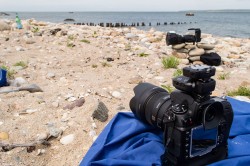Small Flash Tutorial: Working with High Shutter Speed and Flash
[/tps_header]One wonderful feature of the small flash is its ability to sync with our cameras at higher-than-normal shutter speeds. This combination comes in handy when trying to freeze action, for a number of reasons. Using a fast shutter speed cuts down on motion blur when shooting moving subjects in existing light. Combining that fast shutter speed with a punch of even faster flash further amplifies the stopping power of whatever you aim your flash at.
I recently decided to put this combo into play with a couple of friends and a bucket of golf balls. I set out to create some explosive detail shots, conveying the moment of impact when golf ball and club collide. A bit of background knowledge I didn’t have going in: the average golf pro has a swing speed of over 100 MPH. Now, my buddies are no golf pros, but one of them has a mean drive, so I had no idea beforehand how much action we’d be able to freeze. The only thing left to do is to put it to the test and find out.[/tps_header]
Step One
First, let’s compose the shot. As photographers, we’re constantly told to fill the frame. To do this, I used the Sigma 85mm f/1.4, which allowed me to zoom in close without putting my head right in
the path of a swinging golf club (see photo at left). The second benefit of a tight composition is the ability to put an off-camera flash very close to the subject without it being seen in the frame. If you remember from my article in Issue #5 on High Speed Sync (HSS), a lot of power is lost the farther you go beyond your normal sync speed. So getting that flash as close as possible is key.


